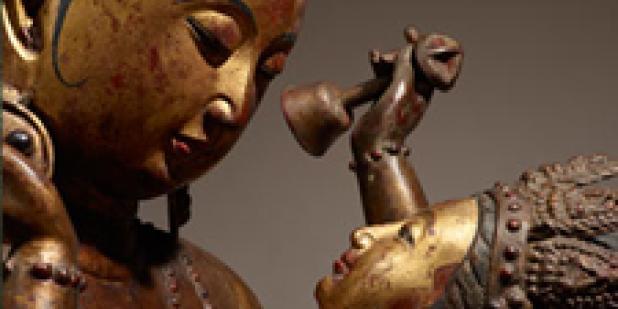Join us for a free one-day workshop for educators at the Japanese American National Museum, hosted by the USC U.S.-China Institute and the National Consortium for Teaching about Asia. This workshop will include a guided tour of the beloved exhibition Common Ground: The Heart of Community, slated to close permanently in January 2025. Following the tour, learn strategies for engaging students in the primary source artifacts, images, and documents found in JANM’s vast collection and discover classroom-ready resources to support teaching and learning about the Japanese American experience.
Noble Change: Tantric Art of the High Himalaya
The Trammell & Margaret Crow Collection of Asian Art in Dallas, TX presents an exhibition that features Himalayan region art.
Where

This exhibition of sculptures and textiles is the first presentation drawn from a collection of tantric art recently acquired by Trammell S. Crow. It inaugurates a series of presentations and programs that will unfold over the coming years, exploring the rich tradition of tantric art made in the Himalayan regions to serve the practices that developed there as Vajrayana Buddhism (in Sanskrit Vajra means “indestructible” and yana means “vehicle” or “path”).
The time is ripe. We are two centuries removed from the early Western fascination with or total rejection of tantra as titillating erotica or stultifying ritual, and more than fifty years removed from the crescendo of the hippie exploitation of tantra to pursue sexual pleasure and free-wheeling states of consciousness, like those offered by mind-altering drugs. In our time, we have a highly visible example of Vajrayana Buddhism in action in Tibet’s spiritual leader, the Dalai Lama, who is accomplished in the most advanced and subtle practices of tantric Buddhism. Followers consider him to be warm, precise, unshakable, generous, courageous, and firmly grounded in reality—its suffering and its nobility. He offers an invitation to come down to earth.
Tantric practices were first designated as distinct from those of other paths by extensive use of mantra. Vajrayana was sometimes labeled Mantrayana. Mantra (Sanskrit for “protection”) is the repeated vocalization of designated sounds in order to protect the mind from its ordinary ego-serving pathways and dedicate awareness to its original nature.
Tantric practices, unlike other Buddhist vehicles, explicitly use the body as the path. Visualization makes use of the power of sight to bring the outside in and the inside out, to dissolve the boundary of our body. Breath control, gestures (mudras), and positions of the body (yogic asanas) are tools to stimulate and direct the flow of energy, along with extensive ritual performances ordering and purifying space and summoning and dispelling energies. On images such as those seen here, as well as in paintings, drawings, and ritual tools, instructions for practice are mapped by a holder of knowledge. Each part of the image is a reminder of practice; art and ritual are memory palaces of teachings.
The effects of these practices are currently of great interest to neuroscientists who are investigating how we make our conscious world. Tantric practice observably changes patterns and places of activity in our brain, laying down new neural networks and reviving discarded pathways. They work with organs and channels in the body that control temperature, mood, circulation, growth, decay, and energy—all of great interest to modern science. And to those who realize the fruits of these practices, they expose a plenum of what is, free from delusions of ego-bound strivings, devoid of binding categories of self-reinforcing thought—vivid beyond our dreams and infinite in compassionate possibilities. This reality is held to be already here, inherent in all existence—its Buddha-nature—and available if we awaken to it.
The art you will see in this exhibition was made to support Tantric practice. It is not art made for art’s sake. Nor are the figures representations of deities with any independent existence. They are empty forms. Some are peaceful, some semi-ferocious, and some fierce. All are compassionate.
Featured Articles
Please join us for the Grad Mixer! Hosted by USC Annenberg Office of International Affairs, Enjoy food, drink and conversation with fellow students across USC Annenberg. Graduate students from any field are welcome to join, so it is a great opportunity to meet fellow students with IR/foreign policy-related research topics and interests.
RSVP link: https://forms.gle/1zer188RE9dCS6Ho6
Events
Hosted by USC Annenberg Office of International Affairs, enjoy food, drink and conversation with fellow international students.
Join us for an in-person conversation on Thursday, November 7th at 4pm with author David M. Lampton as he discusses his new book, Living U.S.-China Relations: From Cold War to Cold War. The book examines the history of U.S.-China relations across eight U.S. presidential administrations.




